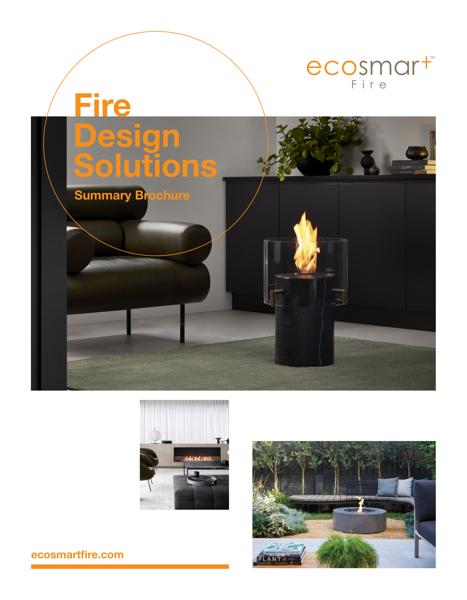Loading image...


Create an instant talking point
Because bioethanol is clean-burning, EcoSmart Fire models do not need a chimney or a flue, or a utility connection – offering the ultimate in design simplicity and flexibility.
Whether you're creating a custom fireplace feature, renovating an existing fireplace, or looking for an out-of-the-box solution, we have an ethanol fireplace to suit your needs.
You May Also Like
Learn More
Ethanol Fireplaces
Ventless Fireplaces
FAQ's
Can you cook on a bioethanol fireplace?
No, you cannot cook on a bioethanol fireplace. Bioethanol fireplaces are classified as decorative appliances intended for occasional use only, not for heating or cooking. They're designed to create ambience safely, but lack the proper heat distribution, surface design, and safety features required for food preparation.
Do ethanol fireplaces smell?
All heating appliances have their own smell be it gas, wood or electric - ethanol fireplaces are no different. e-NRG ethanol fuel is made of fermented plants like sugarcane or corn and is essentially a liquid alcohol. To safely make it “de-natured” and unfit for consumption, substances have been added. The burning of these substances may cause a slight smell upon initial lighting and when the flame is extinguished – similar to when you blow out a candle. e-NRG ethanol fuel is the only fuel recommended for your EcoSmart Fire ethanol fireplace. e-NRG ethanol fuel has the lowest odour and longest burn time on the market. The nice thing about using ethanol is that it’s not dry like gas or smokey like wood.
Can ventless fireplaces be used as a primary heat source?
Ventless bioethanol fireplaces are classified as decorative appliances intended for occasional use. They're designed to create ambience rather than serve as a primary heat source, and regulations specifically prohibit their use for continuous operation or home heating.
Are bioethanol fireplaces safe for homes with children or pets?
Like all fireplace solutions, bioethanol fireplaces can be safe with proper precautions around children and pets. EcoSmart Fire recommends installing certified fire screens, maintaining safe distances from hot surfaces, and never leaving the fire unattended. Children should always be supervised, and pets kept away from the unit during operation due to high surface temperatures.
Are ventless fireplaces safe?
Ventless ethanol fireplaces are safe when properly installed and operated according to manufacturer guidelines. EcoSmart Fire's bioethanol fireplaces meet rigorous safety standards including UL 1370-16 and EN16647 certification. Always ensure sufficient room size and follow all safety protocols.
Where is the best place to install an ethanol fireplace?
Our ethanol fireplaces can be installed virtually anywhere - in walls, cabinets, high-rise buildings, commercial/residential /hospitality spaces, indoors and outdoors. Because EcoSmart Fire’s ethanol fireplaces are ventless, they require no gas line, no electricity, and no chimney for a hassle-free and cost-effective installation. Our ethanol fireplaces have been designed and tested with safety as our top priority. We have outlined requirements for each ethanol burner, ethanol fireplace insert, and ethanol freestanding fireplace in our collection. These guidelines include minimum room size requirements and clearance recommendations for flammable materials and movable objects.Please refer to our manual for more information.
Can I refill my bioethanol fireplace while it's running?
No, you must never refill your bioethanol fireplace while it's running. This poses serious explosion and fire hazards that could result in property damage, injury, or death.Always shut off the appliance and allow it to cool for at least 60 minutes before refuelling. The flame may be difficult to see in daylight conditions, so never assume the burner is off. Even when the flame appears extinguished, the burner remains dangerously hot and volatile vapours may still be present.
Can I convert my existing fireplace to bioethanol?
Yes, you can easily convert your existing fireplace to bioethanol using EcoSmart's VB2 burner, Heritage Grates, or Fireplace Grates. These products transform traditional wood-burning fireplaces into clean-burning bioethanol fires within minutes. Just ensure any gas connections are professionally disconnected first for safety.
How do ethanol fireplaces work?
EcoSmart Fire’s ethanol fireplaces are self-contained, burning bioethanol fuel that is housed within the stainless steel container. A flame regulator controls and stabilizes the flame. With a designated filling area, and easy shut-off mechanism, you can ignite the flame and turn it off in a matter of seconds.View this quick demonstration video to help illustrate the process.
https://youtu.be/OH5uFuAJ2Hg
Do bioethanol fireplaces produce carbon monoxide?
No, bioethanol fireplaces do not produce carbon monoxide when operating correctly. EcoSmart Fire's bioethanol burners produce only heat, steam, and a small amount of carbon dioxide during combustion. This clean-burning characteristic eliminates the need for flues or chimneys, as there are no harmful emissions requiring extraction. However, proper ventilation remains essential for optimal air quality and safety.



























